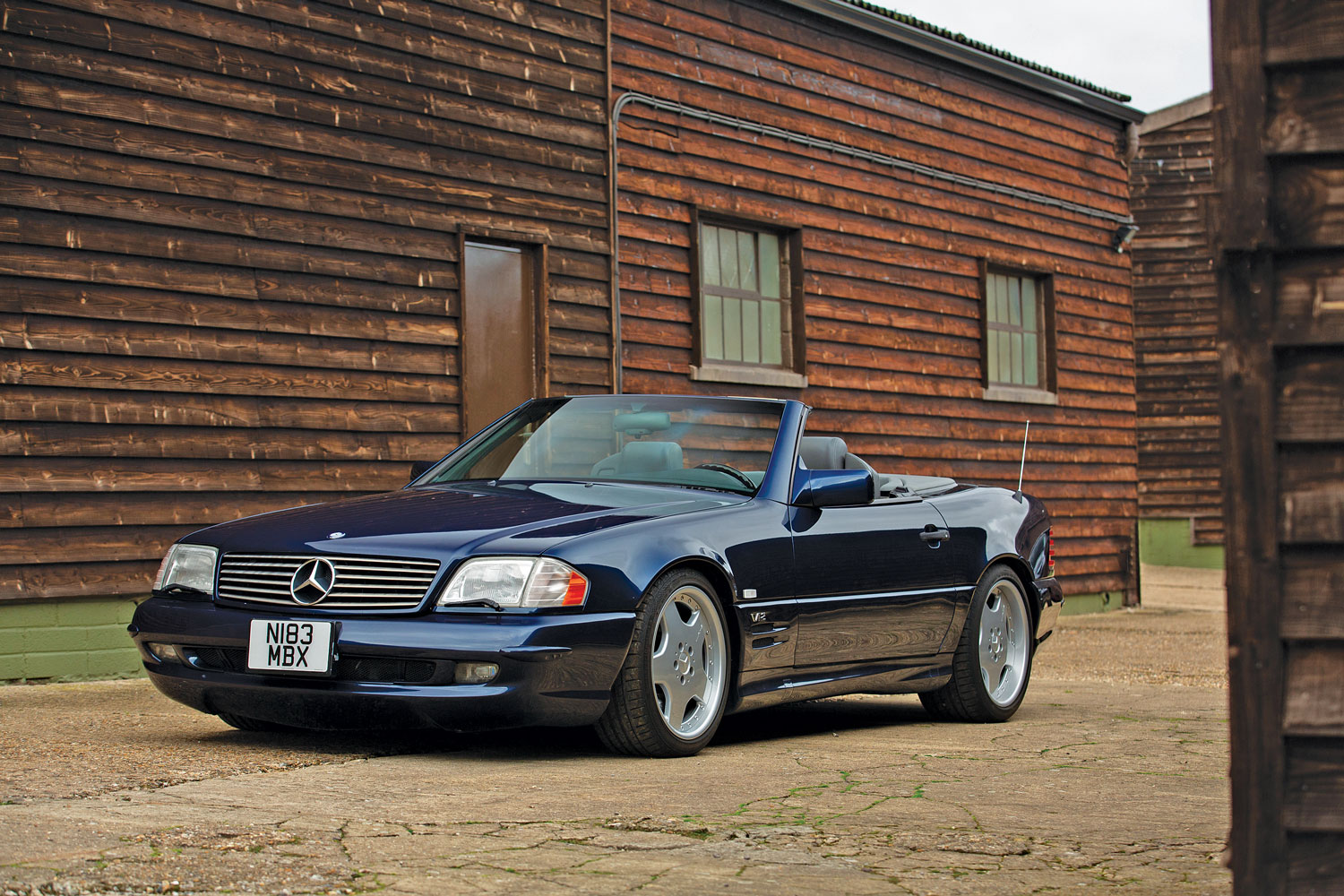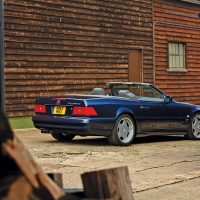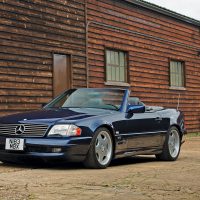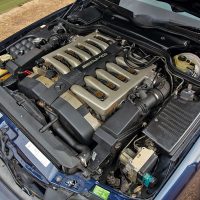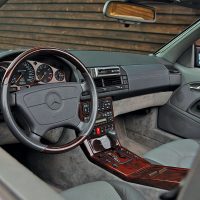SCM Analysis
Detailing
| Vehicle: | 1996 Mercedes-Benz SL70 AMG |
| Years Produced: | 1994–98 |
| Number Produced: | 29 |
| Tune Up Cost: | $650 |
| Chassis Number Location: | On right side of front firewall |
| Engine Number Location: | Stamped into a pad on the oil-pan mounting rail behind the starter |
| Club Info: | Mercedes Benz Club of America |
| Website: | http://www.mbca.org |
| Alternatives: | 1994–96 BMW 850 CSi, 1996–2001 Ferrari 550 Maranello, 1998–2003 Jaguar XK-R |
This car, Lot 142, sold for $149,778 at RM Sotheby’s London, U.K., sale on October 31, 2020.
Another AMG fantasy car that appeared out of the Land of the Rising Sun, this extremely rare SL70 is said to be one of 29 units built by “AMG Japan.” Our subject car represents a somewhat tame departure from the brash, machismo 1980s AMG product, appearing much more visually subtle and mechanically potent than most cosmetically enhanced AMGs.
More go, less show
During the 1990s, a transformation occurred slowly at AMG. The focus moved away from wide-body kits, flashy wheels and bespoke aerodynamics to a new understated AMG look. This was welcome in Japan, where the effects of the bubble economy left few people with the funds to purchase and hot-rod their cars, let alone an expensive Mercedes SL600.
This resulted in a heavy shift to a more hushed performance-driving experience. Concurrently, AMG was producing the C36 sedan in Affalterbach, as well as W124 sedan and W463 G-Class SUV performance variants with the 3.6-liter M104 straight-6 engine. These cars offered only subtle exterior cues to the potency that awaited the driver. Our subject car is no different — the average enthusiast might think it is just a typical SL600 with the compulsory set of AMG Monoblock wheels.
Mercedes’ halo V12
For most Mercedes enthusiasts, there is one uniquely important V12 engine: the M120, as found in our subject car. This is the engine that AMG chose to showcase its over-the-top engineering, with a 7.3-liter capacity being the largest seen on something resembling a production Mercedes. AMG even further developed its own version of this engine, renaming it the M297, for use in the SL73, S73, CL73 and road-going CLK-GTR. The M120 left such a durable impression that the subsequent M137, M275 and even the modern M279 engines live in its shadow.
The versatility of the M120 was derived from its origins. The twin-cam M104 I6 that powered the C36 AMG and various standard E-, S- and SL-Class cars was a natural platform from which to create a new V12. AMG interpreted this shared platform as an excuse to carry out simultaneous enhancements on both the 6- and 12-cylinder variants; hence the AMG 3.6-liter inline 6 spawned new 7.0- and 7.2-liter V12 engines.
The success of the M120 hinged on its DOHC, 48-valve design, its extreme robustness and its ability to be tuned for more power. Pagani even used the M120 in its earth-shattering Zonda until 2016, some 14 years after Mercedes stopped offering it in the SL600. The insane publicity that the Zonda generated helped cement the M120 as a true supercar engine.
According to Jonathan Hodgman of Blueridge Mercedes, my favorite information source for the market on AMG cryptids, owners of Zonda C12 and C12 S models have reportedly purchased whole SL73 models — the ultimate AMG SL of this era — to harvest their engines. The SL73 is even more rare than the SL70 and SL72 and shared its engine with the Zonda S 7.3, with 750 horsepower being attainable. The differences between the SL70 and SL72 are a hotly debated topic, with many details being unclear or highly variable. It is worth noting that some SL73s brought to market are not true 73s, instead being rebadged 70s and 72s or even plain SL600s.
No address on file
There was not a centralized AMG production facility in Japan, but rather a number of small shops, Mercedes dealerships and even individuals that were given permission to use the name. In some cases, permission wasn’t given, but the individual parts needed to build a large-displacement engine were available from Mercedes dealership parts departments, meaning anyone who knew how to build an engine could theoretically create their own SL70. These modern-day hot-rodders used over-the-counter parts, engine-management systems and bolt-on suspension, exhaust and wheels to create examples like our subject car, while applying their personal touches to the fine details. If you were hoping for a car built by a licensed AMG facility in Japan, similar to the one in Affalterbach, Germany, I suggest you curb your expectations.
Transforming bland to sublime
I am not shy about admitting my lukewarm sentiment towards the R129-series SL. There are some notable issues with this model, including Mercedes not providing replacement electronic keys, and crumbling engine wiring on 1993–95 examples. I have to admit that the R129 does have a strong unibody chassis and makes a great performer. While R129s are slowly building a following in the marketplace, a decent SL600 is still a $20,000 car. Given the maintenance cost, they are not great investments, but they do provide inexpensive access to supercar performance while delivering relatively reliable service for a V12-powered automobile.
AMG stamped its factory engines with a “72” designation on the side of the block, near the oil-pan mounting skirt. That said, there are a number of fakes on the market, and any example offered needs to be assessed with skepticism. A set of Monoblocks and an AMG badge is nowhere near adequate proof. That said, AMG levels of performance can be enjoyed at bargain prices by hunting down examples built by Renntech, the spiritual successor to AMG North America. These Renntech versions offer the same performance and reliability at a fraction of the price, with the thrill of an exhausting hunt.
The market for genuine, limited-production AMG cars is driven by demand; there simply aren’t enough of them. In a normal market, the lack of centralized production in Japan would render this a B- or C-grade AMG car. But due to the overwhelming lack of supply, anything with the right parts added gets a pass, and sells for eye-watering prices. As the AMG market continues to gain steam and enthusiasts become ever more picky about the histories of these cars, this SL70 may be seen as well sold in the near future. But for now, we’ll call this one fairly bought. ♦
(Introductory description courtesy of RM Sotheby’s.)
